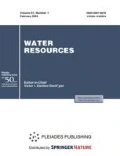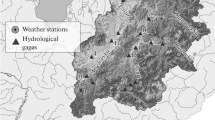Abstract
The article presents the experience in the application of a hydrological conceptual model HBV, including its standard version and modifications, to studying runoff-formation processes on small experimental catchments in the upper reaches of the Ussuri R. based on field observation data in the warm seasons from 2012 to 2019. It was shown, that, in many cases, whatever the structure of the model, the quality of calculations was satisfactory, and the flood events were simulated with a high quality. All versions of the HBV model used in the study have been found to have drawbacks, either common or individual. The difference between the structures of the model and their effect on the estimated runoff in the outlet section has been demonstrated. Against to the standard version of HBV with two storages, the three storages version has not improved the efficency of runoff modeling. The standard structure of HBV was found to be optimal in terms of agreement with the natural processes of runoff formation and the quality of runoff simulation in small mountain rivers.



Similar content being viewed by others
REFERENCES
Vinogradov, Yu.B., Matematicheskoe modelirovanie protsessov formirovaniya stoka (Mathematical Modeling of Runoff Formation Processes), Leningrad: Gidrometeoizdat, 1988.
Gartsman, B.I., Gubareva, T.S., Lupakov, S.Yu., Orlyakovskii, A.V., Tarbeeva, A.M., Shamov, V.V., and Shekman, E.A., The forms of linear structure of overland flow in medium-height mountain regions: case study of the Sikhote Alin, Water Resour., 2020, vol. 47, no. 2, pp. 179–188.
Gartsman, B.I., Shamov, V.V., and Tret’yakov, A.S., A system of water balance models of a small river basin, Geogr. Prir. Res., 1993, no. 3, pp. 27–36.
Gel’fan, A.N., Dinamiko-stokhasticheskoe modelirovanie formirovaniya talogo stoka (Dynamic-Stochastic Modeling of Snowmelt Runoff Formation), Moscow: Nauka, 2007.
Gubareva, T.S., Gartsman, B.I., Shamov, V.V., Lutsenko, T.N., Boldeskul, A.G., Kozhevnikova, N.K., and Lupakov, S.Yu., Runoff components of small catchments in the Sikhote-Alin: generalization of the results of field measurements and tracer modeling, Izv. Ross. Akad. Nauk. Ser. Geogr., 2019, no. 6, pp. 126–140. https://doi.org/10.31857/S2587-556620196126-140
Motovilov, Yu.G. and Gel’fan, A.N., Modeli formirovaniya stoka v zadachakh gidrologii rechnykh basseinov (Runoff Formation Models in the Problems of Hydrology of River Basins), Moscow: Ross. Akad. Nauk, 2018. https://doi.org/10.31857/S9785907036222000001
Tereshkina, A.A., Pshenichnikova, N.F., Bugaets, A.N., Golodnaya, O.M., and Krasnopeev, S.M., Digital soil map of Sokolovka River catchment (the territory of Verkhneussuriiskaya Station, Biodiversity Federal Research Center, Far East Branch, Russian Academy of Sciences), in Geograficheskie i geoekologicheskie issledovaniya na Dal’nem Vostoke (Geographic and Geoecological Studies in the Far East), Vladivostok: Dal’nauka, 2019, issue 1, pp. 126–136. https://doi.org/10.35735/tig.2019.26.44.012
Shamov, V.V. and Lupakov, S.Yu., Hydrochemical indication of faults in the valleys of small mountain rivers in the Southern Primor’e Region, in Zakonomernosti proyavleniya erozionnykh i ruslovykh protsessov v razlichnykh prirodnykh usloviyakh (Regularities in Manifestations of Erosion and Channel Processes under Different Natural Conditions), Moscow: Lenand, 2019, pp. 409–411.
Bergstrom, S., Development and Application of a Conceptual Runoff Model for Scandinavian Catchments, Norrkoping, Sweden: Univ. Lund. Bull., 1976.
Beven, K., Rainfall-Runoff Modelling. The Primer, Chichester: UK: Wiley, 2001. https://doi.org/10.1002/9781119951001
Beven, K., Towards a methodology for testing models as hypotheses in the inexact sciences, Proc. Royal Society A, 2019, vol. 475, no. 2224. https://doi.org/10.1098/rspa.2018.0862
Bugaets, A.N., Gartsman, B.I., Gonchukov, L.V., Lupakov, S.Y., Shamov, V.V., Pshenichnikova, N.F., and Tereshkina, A.A., Modeling the hydrological regime of small testbed catchments based on field observations: a case study of the Pravaya Sokolovka River, the Upper Ussuri River basin, Water Resour., 2019, vol. 42, no. S2, pp. S8–S16. https://doi.org/10.1134/S0097807819080037
Butts, M.B., Payne, J.T., Kristensen, M., and Madsen, H., An evaluation of the impact of model structure on hydrological modelling uncertainty for streamflow simulation, J. Hydrol., 2004, vol. 298, pp. 242–266. https://doi.org/10.1016/j.jhydrol.2004.03.042
Cornelissen, T., Diekkruger, B., and Giertz, S., A comparison of hydrological models for assessing the impact of land use and climate change on discharge in a tropical catchment, J. Hydrol., 2013, vol. 498, pp. 221–236. https://doi.org/10.1016/j.jhydrol.2013.06.016
Grayson, R.B. and Bloschl, G., Spatial Patterns in Catchment Hydrology: Observations and Modelling, UK: Cambridge: Univ. Press, 2000. https://doi.org/10.1002/hyp.5215
Huang, J.-C., Lee, T.-Y., Lee, J.-Y., Hsu, S.-C., Kao, S.-J., and Chang, F.-J., Assessing hydrological model behaviors by intercomparison of the simulated stream flow compositions: case study in a steep forest watershed in Taiwan, Hydrol. Earth Syst. Sci. Discuss., 2013, vol. 10, pp. 855–893. https://doi.org/10.5194/hessd-10-855-2013
Kirchner, J.W., Getting the right answers for the right reasons: linking measurements, analyses, and models to advance the science of hydrology, Wat. Resour. Res., 2006, vol. 42, W03S04. https://doi.org/10.1029/2005WR004362
Krysanova, V. and Hattermann, F.F., Intercomparison of climate change impacts in 12 large river basins: overview of methods and summary of results, Clim. Change, 2017, vol. 141, pp. 363–379. https://doi.org/10.1007/s10584-017-1919-y
Moriasi, D.N., Arnold, J.G., Van Liew, M.W., Bingner, R.L., Harmel, R.D., and Veith, T.L., Model evaluation guidelines for systematic quantification of accuracy in watershed simulations, Trans. ASABE, 2007, vol. 50, no. 3, pp. 885–900. https://doi.org/10.13031/2013.23153
Mroczkowski, M., Raper, G.P., and Kuczera, G., The quest for more powerful validation of conceptual catchment models, Wat. Resour. Res., 1997, vol. 26, no. 10, pp. 2275–2286. https://doi.org/10.1029/97WR01922
Nash, J.E. and Sutcliffe, J.V., River flow forecasting through conceptual models. Pt 1. A discussion of principles, J. Hydrol., 1970, vol. 10, no. 3, pp. 282–290.
Perrin, C., Michel, C., and Andreassian, V., Improvement of a parsimonious model for streamflow simulation, J. Hydrol., 2003, vol. 279, pp. 275–289.
Rango, A. and Martinec, J., Revisiting the degree-day method for snowmelt computations, Water Resour. Bull., 1995, vol. 31, pp. 657–669. https://doi.org/10.1111/j.1752-1688.1995.tb03392.x
Schaefli, B. and Gupta, H.V., Do Nash values have value?, Hydrol. Processes., 2007, vol. 21, pp. 2075–2080. https://doi.org/10.1002/hyp.6825
Seibert, J. and Vis, M., Teaching hydrological modelling with a user-friendly catchment-runoff-model software package, Hydrol. Earth Syst. Sci., 2012, vol. 16, no. 9, pp. 3315–3325. https://doi.org/10.5194/hess-16-3315-2012
Smith, M.B., Seo, D.-J., Koren, V.I., Reed, S., Zhang, Z., Duan, Q.-Y., Moreda, F., and Cong, S., The distributed model intercomparison project (DMIP): motivation and experiment design, J. Hydrol., 2004, vol. 298, nos. 1–4, pp. 4–26. https://doi.org/10.1016/j.jhydrol.2004.03.040
Uhlenbrook, S., Seibert, J., Leibundgut, C., and Rodhe, A., Prediction uncertainty of conceptual rainfall-runoff models caused by problems in identifying model parameters and structure, Hydrol. Sci. J., 1999, vol. 44, no. 5, pp. 779–797. https://doi.org/10.1080/02626669909492273
Funding
This study was supported by the Russian Science Foundation, project no. 17-77-30 006, and the Russian Foundation for Basic Research, project no. 19-05-00326.
Author information
Authors and Affiliations
Corresponding author
Additional information
Translated by G. Krichevets
Rights and permissions
About this article
Cite this article
Lupakov, S.Y., Bugaets, A.N. & Shamov, V.V. Application of Different Structures of HBV Model to Studying Runoff Formation Processes: Case Study of Experimental Catchments. Water Resour 48, 512–520 (2021). https://doi.org/10.1134/S0097807821040126
Received:
Revised:
Accepted:
Published:
Issue Date:
DOI: https://doi.org/10.1134/S0097807821040126




